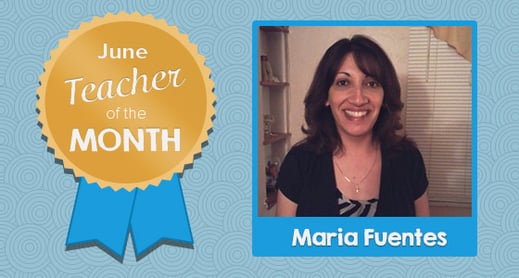
This month, we’re featuring Maria Fuentes, a preschool teacher at Faith Early Learning Center in Ohio. When her coach Rozlyn nominated her, she wrote that Maria, “exhibits a true love of children which is observed in her daily interactions with them.”
Maria supports dual language learners (DLL) and talked to me about how she got into teaching, what is so critical about supporting DLL, and how she thinks about CLASS in conjunction with other assessment and monitoring tools.
Tell me about you and how you got into teaching, specifically DLL.
I was actually studying to become a nurse when my older sister pulled me into the classroom. Both of my sisters are teachers. My older sister was teaching 6th grade DLL. She had 20-25 kids by herself and needed help. So, I started volunteering. I helped out for two years by grading papers, joining school committees, and more. I fell in love with the classroom environment and decided teaching was what I wanted to do. That was 18 years ago. Since then, I completed my master’s in English to Speakers of Other Languages (ESOL), and I now teach 3-5 year-olds at Faith Early Learning (part of Centers for Family and Children).
In our program, we have Spanish-speaking families, Arabic-speaking families, families from Burma, Albania, different parts of Africa, and more. Many of these children speak little-to-no English. I was a DLL in school—I know how scary it can be.
Instead of thinking of my job as teaching these children English, I think of it as providing language support. I try to find different resources to see what ways I can help the children and the families in an English-speaking setting. One way I do this is by labeling items around our classroom in different languages and by singing songs in other languages. Even if I don’t speak their language, I work with each of the parents, teaching them how to say certain things. And I bring that into the classroom.
How did you learn about CLASS?
Our center uses multiple monitoring and assessment tools—like Preschool Program Quality Assessment (PQA), internal monitoring and content standards, and CLASS—to look at program quality. Our agency has CLASS assessors come in twice a year. When we began CLASS assessments, our agency explained the tool and gave us an overview of what interactions should look like.
When you use many tools, it can be overwhelming. But, I think a lot of what the CLASS tool focuses on is common sense, and CLASS fits really well with the other tools. I might be planning my curriculum as part of the standards, but I also think about how to incorporate Language Modeling and Concept Development into our activities.
You have to remember that these monitoring tools are for the benefit of the children. If your center or agency introduces yet another monitoring tool, don’t stress. Think about what it brings to your teaching. I’m always looking for new and different ways to improve and that’s why I like the CLASS.
Talk to me about how you incorporate CLASS-based interactions into your classroom?
Let’s look at an example—I might be teaching my students how to put on a coat. We practice dressing the dolls in the housekeeping center and then connect that activity to the act of putting on our own coats. Connecting concepts is important. I also have started focusing more on peer interactions by having the children help each other. Each child is a part of the classroom community, so those peer-to-peer interactions are really important.
When I’m working on lesson plans, I try and focus on how I can incorporate Instructional Support dimensions into the day (and other dimensions as well). You have to think about all of your interactions and that isn’t always easy. You have be intentional and reflective. Every time we have an assessment done, we discuss our scores. I might feel like I’m doing a great job, but when I see the observation notes or my CLASS scores, I’m able to see where I can improve (and where I’m doing well). I always feel like I can do better so I use the scores to help me focus my improvement goals. I want perfection (even though no one is perfect), so I ask myself, “What can I do to get a 7 across the board (even if it’s not possible)?” It’s something I’m always working towards.
If you could share advice with other teachers, what would it be?
In the early childhood field, you have to embrace what you do and love what you do. Children are like little sponges who are eager to learn more. That should be your motivation. You, as the teacher, are a role model for them. You might have some children that provide a challenge for you. Teaching isn’t easy but don’t give up. Children need you. When a child gives you a hug or when you see them grow, it's all worth it.
Thanks for sharing your story, Maria. Your students are lucky to have such an understanding and passionate teacher. And thank you to Rozlyn Grant for telling us about Maria's dedication to her students.
If you know of any deserving teachers who go above-and-beyond in the classroom, let us know.

